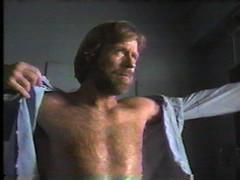Review: Missing In Action (1984)
Synopsis
Colonel James Braddock (Chuck Norris) spent about ten years as a P.O.W. during the Vietnam conflict. Now he's back in the States, watching Spider-Man cartoons, drinking beer, and having flashbacks. The media has called Braddock one of the most outspoken proponents of the theory that there are still U.S. servicemen being held in Vietnam (although I question whether someone can be considered outspoken when they rarely utter more than five words a day.)
Braddock agrees to go to Ho Chi Minh City with a U.S. Senator to make a formal inquiry about the M.I.A.s, but General Trau (James Hong), the Vietnamese official in charge, denies the accusations and accuses Braddock of war crimes. This makes Braddock whip off his frosted sunglasses and frown ever so slightly. That night, he sneaks into Trau's mansion and asks him where the M.I.A.s are while politely applying a knife point to the General's throat. Trau tells him what he wants to know but then pulls a gun from under his pillow, so Braddock is forced to fillet him.
Armed with the location of the camp where the M.I.A.s are being held, Braddock heads over to Thailand to look up an old friend named Tuck (M. Emmet Walsh). Tuck agrees to take him back to 'Nam on his boat. They run into complications when a squad of Vietnamese assassins come after them. The assassins are led by Vinh - the same man who tortured Braddock in his P.O.W. days. Vinh and Braddock have a nebulous verbal exchange before Braddock shoves an axe blade through Vinh's sternum.
Tuck and Braddock roll back into Vietnam with guns a-blazin' and blow up everything in sight. They find the M.I.A.s and use a helicopter to get them out of the jungle. Braddock sets the helicopter down in Ho Chi Minh City and runs into the Government headquarters for a climactic showdown with General Trau before remembering that he already killed him earlier in the film.
Comments
The horror...the horror... Well, once again the Canon film studio has brought us a nuanced, thought-provoking meditation on a serious subject of international importance. It's good to know that they would never exploit the very real plight of M.I.A.s for a cheaply made, cartoonish action movie. Of course, when you're making a film that tackles such a sensitive and controversial topic, the go-to guy for your leading man has got to be Chuck Norris.
Chuck's acting is in fine form here and whether he's staring blankly into space or bobbing up from a river to mow down Vietcong with his M-60, you'll be convinced that he was the right choice for the role. His roundhouse kicks and karate chops are in low numbers here, but there is a significant number of explosions to help make up for that. I think of Chuck's acting as being a bit like a hand-grenade: not a pretty thing to see in use but effective nonetheless.
For whatever reason, the director of Missing in Action became fixated on the dramatic potential of Braddock changing his shirt. Approximately every five minutes we get another scene of our hero stripping off his top. It goes beyond a mere excuse to show Chuck Norris' hairy chest - this is a full-blown shirt-changing obsession. And it's not just the removal of garments the director relishes; there's a scene in Thailand where Braddock puts on a fresh shirt and then spends what seems like twenty minutes carefully buttoning and tucking it in. For those directors who have yet to explore this exciting dramatic device, please take note.
Another unconventional dramatic technique employed here is to have the hero kill off all the major villains before the film is half-over. Call me a stodgy conventionalist but I like my movie climaxes to be at the end of the movie instead of in the middle. Trau and Vinh are both history well before the film's conclusion, and it's a little hard to care when Braddock brings the M.I.A.s into the Vietnamese government offices for a big confrontation with some guy we've never seen before.
The minor characters in Missing in Action really give the film a surrealistic flavor. There's the de facto leader of the M.I.A.s (in other words, the only one given any lines or individual personality) - with his dark stubble and droopy eyes he closely resembles a circus clown of the "sad hobo" variety. There's a French arms dealer who wears huge sunglasses and what appears to be a woven flower planter on his head. And who could forget the skinny Thai lounge singer whose only song is an extended, off-key version of Rod Stewart's "Do Ya Think I'm Sexy?" accompanied by accordion? It's these little details that put this film up on the next level.
Final Analysis
Why is Missing in Action not being screened in our nation's history classrooms? I learned everything I know about Vietnam from Chuck Norris. You can keep your Apocalypse Nows and your Full Metal Jackets and your Platoons - just give me Chuck with a headband and a bag of C4, running through the jungle, blowing up God's creation and I'll be as pleased as punch. A solid entry in the Canon / Norris library of explosion-rich cinema. Recommended for Chuck aficionados and those who enjoy chanting "U-S-A!! U-S-A!! U-S-A!!"



